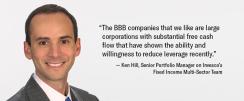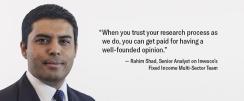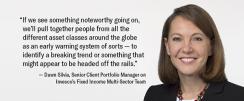Fixed income opportunities are out there if you know where to look for them and have the tools to unearth them. At Invesco, the Active Multi-Sector Credit Strategy centers on four pillar asset classes – global high yield, bank loans, emerging market debt, and global investment grade – and has sufficient flexibility to be tilted at any point in the cycle to modify risk levels as dictated by market fluctuations. This full-cycle strategic aspect is accompanied by tactical allocation bands which allow portfolio managers to opportunistically position the overall strategy. Identifying such potential opportunistic plays was the topic of conversation when II recently spoke with three members of Invesco’s Fixed Income Multi-Sector Team: Ken Hill, Senior Portfolio Manager; Rahim Shad, Senior Analyst; and Dawn Silvia, Senior Client Portfolio Manager.
Looking at the macroeconomic landscape, what has happened recently that gives context to why a multi-sector opportunistic credit strategy makes sense right now?
Ken Hill: Long maturity yields are near record lows, so the search for reasonable returns in fixed income is becoming more intense and puts extra importance on the ability to search globally for investment opportunities across a wide range of asset classes and sectors. But there’s a lot of risk out there – rising geopolitical risk, specifically U.S./China trade tension, Brexit, and the impeachment process in the U.S., and the search for returns should take those risks into account. Our multi-sector credit strategy is designed to opportunistically dial risk up and down, so we can potentially provide sufficient returns without taking undue risk.
Are there particular business sectors you’re keeping an eye on for opportunities in corporates?
Rahim Shad: For the most part, the opportunistic strategy is business sector agnostic because we’re trying to position investors wherever the best opportunities emerge. That said, thematically speaking, we have been pretty consistent in liking 5G and network technology, starting four years ago or so when we determined connectivity would be central in the push toward automation. Now that the picture of the timeline is a little clearer on the execution of 5G itself, we’ve started looking deeper into derivative plays on both the service side of things and equipment – the infrastructure and lifeblood of these technologies. As 5G rolls out over the next few years we’ll see the possible benefits of the first derivative plays, then it should trickle down into second derivatives.
What about artificial intelligence?
Shad: We obviously watch it and there are implications, but a lot of the companies working on AI are startups that have no debt. It’s going to impact everything we were just talking about eventually, but at the moment we don’t have any direct AI plays.

Do the opportunities look different through the lens of credit sectors?
Hill: We think BBB credit is an interesting story and we’ve expressed that in our opportunistic bucket. BBs are historically expensive as high yield investors have moved up in quality so far this year, and we feel the narrative of fallen angels – BBBs downgraded to high yield – is a bit overdone. The BBB companies that we like are large corporations with substantial free cash flow that have shown the ability and willingness to reduce leverage recently.
Part of your strategy focuses on private companies. What advantages do you see in them?
Shad: We look for opportunities across the spectrum, and overall that’s an expansive set. In that context, depending on which index you reference, up to a third of the companies are private. Compared to public companies, it’s more challenging to gather information on privates, but we welcome that challenge because we have an advantage in those situations.

Shad: Any situation where we feel we’ll have an informational advantage. It’s not a magic formula. For example, our experience with sponsors over the last couple of decades helps us avoid certain situations because they are conscious of what creditors are looking for, and we’ve had a really good experience with them in the past.
We are also drawn to companies that are a source of conflicted opinions in the market because that’s really where the opportunity is going to be. When you trust your research process as we do, you can get paid for having a well-founded opinion.
A third scenario is a name that falls into the cracks because it’s off-index or just not as well-covered by analysts as it should be. The street may be covering it, but perhaps it has traveled across two or three different analysts.
Sticking to the private realm, do smaller companies offer an opportunity advantage as well?
Shad: There’s a potential advantage any time an issuer is less followed. You can get more information on it if you stick to it and dig deep. There could be hidden value that’s easily missed by eyes covering the wider market.
Safe to say that uncovering opportunities in private companies is closely tied to your research process?
Shad: Yes, and the key component of our process is that it allows us to level set risk across analysts, sectors, and regions. Our view is always forward looking because we want to see where these credits are going. And we’re looking at a normalized view of credits, not trying to pick the tops and the bottoms. That means we identify the big picture view on a company, and that is important in establishing the valuation that drives our internal grading and investment process.
Speaking of risk, how do you integrate risk mitigation into high-yield credit?
Hill: All our high yield picks go through an extensive credit review process with built-in safeguards to make sure the names we invest in are either turnaround stories or free cash-flow generating companies. This is scrutinized by the entire high yield team, from analysts to the most senior members of the high yield team.
Also, because of the way our holistic strategy is designed, we have a full suite of hedging tools at our disposal, so we can control credit risk at the overall portfolio level. So, there are two separate layers ensuring that credit risk is managed in the portfolio.

Dawn Silvia: Our platform really is an advantage for us because it ensures that that everyone on our fixed income team is communicating across all the sectors. Instead of isolated small teams, we share knowledge and collaborate with our peers across the organization. We have team members in 14 locations globally, and the platform allows each person access to real-time data and information. Every morning we have a global team call and cover each asset class, but just as important we hear the voices and know the people in the different investment centers around the world, so when we have a question, we can just pick up the phone and call them.
If we see something noteworthy going on, we’ll pull together people from all the different asset classes around the globe as an early warning system of sorts – to identify a breaking trend or something that might appear to be headed off the rails.
Start a conversation about your fixed income portfolios. Learn more.
This article is for US Institutional Investor Use Only. Content was developed in November 2019. This is for informational purposes only and is not an offer to buy or sell any financial instruments. As with all investments there are associated inherent risks. This should not be considered a recommendation to purchase any investment product. The opinions expressed in this article are those of the authors and are based on current market conditions and are subject to change without notice. These opinions may differ from those of other Invesco investment professionals.
Asset allocation, diversification and low or negative correlation do not guarantee a profit or eliminate the risk of loss. Alternative products typically hold more non-traditional investments and employ more complex trading strategies. Investors considering alternatives should be aware of their unique characteristics and additional risks from the strategies they use. Forward-looking statements are not guarantees of future results. They involve risks, uncertainties and assumptions. There can be no assurance that actual results will not differ materially from expectations.
Institutional Separate Accounts and Separately Managed Accounts are offered by Invesco Advisers, Inc. and other affiliated investment advisers, which provide investment advisory services and do not sell securities. Invesco Advisers Inc. is an investment adviser; it provides investment advisory services to individual and institutional clients and does not sell securities.
NA11927






